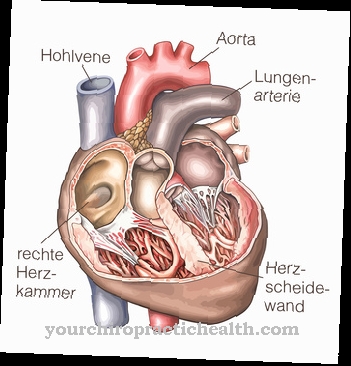The Vascularization is the connection of an organ to the blood system and can therefore also correspond to the formation of new smaller vessels. In the case of pathological neoplasms such as the system connection of a tumor, we also speak of neovascularization. In medical practice, vascularization plays a primarily therapeutic role.
What is vascularization?

With the term vascularization, medicine refers to two different contexts. On the one hand, the term refers to the entire vascular connection of a specific organ. Even more often, however, the medical practitioner uses the word to refer to the so-called angiogenesis. This process corresponds to the formation of new vessels in the human body. Angiogenesis is the growth of vessels that arise from sprouting or splitting on the basis of pre-formed blood vessels.
The formation of new vessels from progenitor cells of the endothelium must be distinguished from this type of vascularization and is also known as vasculogenesis. Vasuclogenesis is particularly relevant for the development of the vascular system in the embryonic period. Angiogenesis plays a role especially in the repair processes of wound healing. The final type of neovascularization is arteriogenesis, in which arteries and arterioles are formed on the basis of smooth muscle cells.
All forms of new blood vessel formation are also referred to as neovascularization within an adult organism. Neovascularization can also be used in the case of neovascularization with pathological value.
Function & task
The vascularization as a blood vessel system connection refers to the blood circulation as a flow system. The system runs from the heart in a network of individual blood vessels through the body and thus ensures survival. The blood vessel system ensures the metabolism of every organ, tissue and every body cell. In this way it maintains the chemically physiological level of body fluids.
The blood primarily transports oxygen from the lungs to the individual cells and removes carbon dioxide from there. Nutrients from digestion are also transported to organs and tissues via the blood. The individual cells receive fats, sugar and protein, which they consume, process or store. The resulting waste products are carried away with the blood into other tissues. In addition, messenger substances such as hormones or immune cells are transported to their place of use in the blood system.
The totality of the vessels of a certain organ fulfills all of the mentioned tasks and is called vascularization. Vascularization in the sense of new formation processes with small blood vessels as a result corresponds to the formation of vascular structures with endothelial cells, pericytes and smooth muscle cells. These regeneration processes are relevant in the context of wound healing and the associated repair processes.
In the broadest sense, the two meanings of vascularization overlap. The common point of intersection corresponds to the supply of tissue sections with a system of vessels and blood capillaries.
The liver is considered to be well-vascularized tissue. It is particularly rich in blood vessels. This means that in the event of an injury in this type of tissue, there is significantly more bleeding than in weakly vascularized tissue such as tendons.
Illnesses & ailments
Vascularization in the sense of angiogenesis is of great importance in the medical clinic, for example in connection with tumors. A solid tumor depends on the growing network of capillaries. In this context we are talking about tumor-induced angiogenesis. This capillary network supplies the tumor with nutrients and oxygen. Every tumor from two mm³ is dependent on the formation of new vessels. Without the vascular connection, tumors remain asymptomatic and have no clinical relevance.
Suppression of vascularization restricts the growth of a tumor accordingly. Anti-angiogenic therapeutic approaches reduce vascularization and thus blood flow to tumors. VEGF-neutralizing monoclonal antibodies such as bevacizumab have been allowed for metastatic colon cancer since 2004. Today this type of therapy is also used for breast cancer, lung cancer or kidney cancer.
Pro-angiogenic therapy must be distinguished from this. It is based on angiogenic growth factors and is used, for example, to treat arteriosclerosis. Above all, the potent angiogenic growth factor FGF-1 is used. Pro-angiogenic therapies can also play a role in chronic wound healing disorders.
The vascularization-promoting therapy corresponds to either a protein therapy, a gene therapy or a cell therapy. The use of growth factors corresponds to protein therapy. The gene therapy studies to promote vascularization have so far mainly used the gene that codes for the angiogenic growth factor in DNA. On this basis, the gene therapy route can correspond to an adenovirus-mediated gene transfer, for example. So far, however, unsolved problems have weighed on gene therapy. For example, these therapeutic approaches increasingly lead to gene transfection, which can be accompanied by an undesirable reaction of the immune system. The potential toxicity of the carrier viruses also represents an unsolved problem with these approaches.
Cell therapy that promotes vascularization is based on the transfer of different cell types. This therapeutic approach is still in its infancy. The current stage corresponds to an initial stage. Studies with a small number of patients are available. However, these studies show relatively conflicting results. So far, cells of various types have been used for transfer. In addition to different forms of adult stem cells such as the endothelial progenitor cells, hematopoietic and mesenchymal stem cells were used in the respective pilot studies.
























.jpg)



